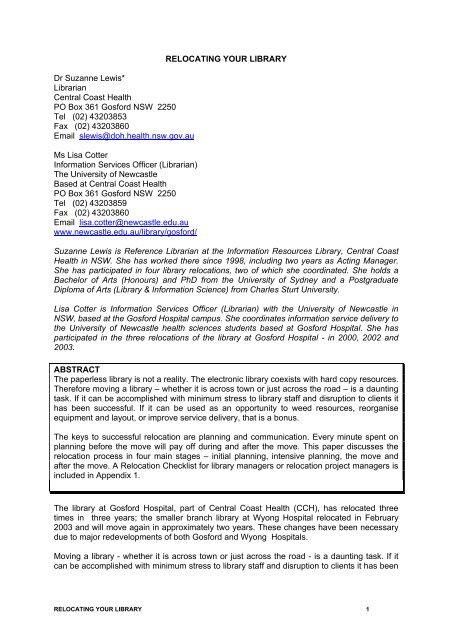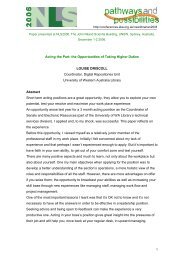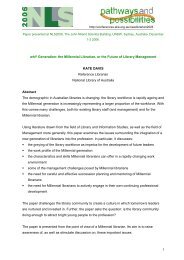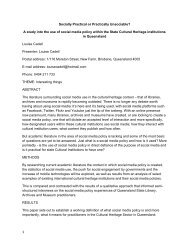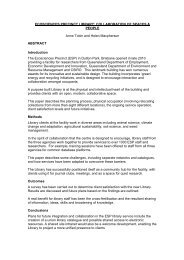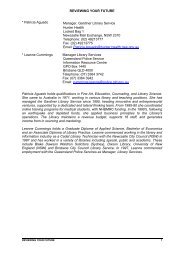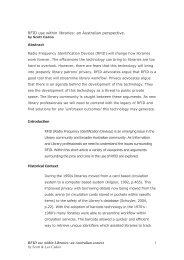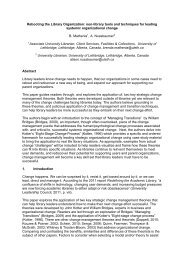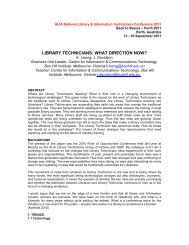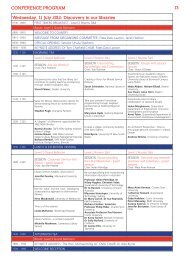RELOCATING YOUR LIBRARY Dr Suzanne ... - ALIA conferences
RELOCATING YOUR LIBRARY Dr Suzanne ... - ALIA conferences
RELOCATING YOUR LIBRARY Dr Suzanne ... - ALIA conferences
Create successful ePaper yourself
Turn your PDF publications into a flip-book with our unique Google optimized e-Paper software.
<strong>Dr</strong> <strong>Suzanne</strong> Lewis*<br />
Librarian<br />
Central Coast Health<br />
PO Box 361 Gosford NSW 2250<br />
Tel (02) 43203853<br />
Fax (02) 43203860<br />
Email slewis@doh.health.nsw.gov.au<br />
Ms Lisa Cotter<br />
Information Services Officer (Librarian)<br />
The University of Newcastle<br />
Based at Central Coast Health<br />
PO Box 361 Gosford NSW 2250<br />
Tel (02) 43203859<br />
Fax (02) 43203860<br />
Email lisa.cotter@newcastle.edu.au<br />
www.newcastle.edu.au/library/gosford/<br />
<strong>RELOCATING</strong> <strong>YOUR</strong> <strong>LIBRARY</strong><br />
<strong>Suzanne</strong> Lewis is Reference Librarian at the Information Resources Library, Central Coast<br />
Health in NSW. She has worked there since 1998, including two years as Acting Manager.<br />
She has participated in four library relocations, two of which she coordinated. She holds a<br />
Bachelor of Arts (Honours) and PhD from the University of Sydney and a Postgraduate<br />
Diploma of Arts (Library & Information Science) from Charles Sturt University.<br />
Lisa Cotter is Information Services Officer (Librarian) with the University of Newcastle in<br />
NSW, based at the Gosford Hospital campus. She coordinates information service delivery to<br />
the University of Newcastle health sciences students based at Gosford Hospital. She has<br />
participated in the three relocations of the library at Gosford Hospital - in 2000, 2002 and<br />
2003.<br />
ABSTRACT<br />
The paperless library is not a reality. The electronic library coexists with hard copy resources.<br />
Therefore moving a library – whether it is across town or just across the road – is a daunting<br />
task. If it can be accomplished with minimum stress to library staff and disruption to clients it<br />
has been successful. If it can be used as an opportunity to weed resources, reorganise<br />
equipment and layout, or improve service delivery, that is a bonus.<br />
The keys to successful relocation are planning and communication. Every minute spent on<br />
planning before the move will pay off during and after the move. This paper discusses the<br />
relocation process in four main stages – initial planning, intensive planning, the move and<br />
after the move. A Relocation Checklist for library managers or relocation project managers is<br />
included in Appendix 1.<br />
The library at Gosford Hospital, part of Central Coast Health (CCH), has relocated three<br />
times in three years; the smaller branch library at Wyong Hospital relocated in February<br />
2003 and will move again in approximately two years. These changes have been necessary<br />
due to major redevelopments of both Gosford and Wyong Hospitals.<br />
Moving a library - whether it is across town or just across the road - is a daunting task. If it<br />
can be accomplished with minimum stress to library staff and disruption to clients it has been<br />
<strong>RELOCATING</strong> <strong>YOUR</strong> <strong>LIBRARY</strong> 1
10th Asia Pacific Special Health and Law Librarians Conference – Adelaide 24–27 Aug 2003<br />
successful. If it can be used as an opportunity to weed resources, reorganise equipment and<br />
layout, or improve service delivery, that is a bonus.<br />
The keys to successful relocation are planning and communication. Every minute spent on<br />
planning before the move will pay off during and after the move. Measure twice (or three or<br />
four times) and move once. Time spent communicating with staff, removalists,<br />
subcontractors, other departments within your organisation, and clients will also pay<br />
dividends providing the communication is clear, non-contradictory and well documented.<br />
Nobody involved in the relocation should be able to say 'I didn't know' or 'I wasn't told'.<br />
STAGE 1 – INITIAL PLANNING<br />
Destination<br />
A library may move to a brand new, purpose built facility, to a fully renovated area, or to a<br />
temporary location where no modification of the physical space is possible.<br />
Whatever the scenario, try to have as much input as possible into your final destination –<br />
both the actual location and the configuration of the space available. For a special library<br />
such as ours, proximity to clinical areas was an important consideration. At present we are<br />
separated from the main clinical areas by a large building site and client numbers have fallen<br />
accordingly. However we have noticed a concurrent rise in telephone and email enquiries.<br />
Eventually, when the Gosford redevelopment is complete, access from clinical areas to the<br />
library will be significantly easier.<br />
Budget<br />
A relocation budget should be determined as soon as possible. The cost of the relocation<br />
may be considerable depending on the size of your library and access for the removalists.<br />
Therefore, the relocation should be budgeted for separately from construction and fit out of<br />
the new area.<br />
Don’t be tempted to make the budget stretch further by using library staff or volunteers to<br />
carry out the actual move. Use of untrained, unsuitable labour has significant occupational<br />
health and safety risks and may leave the library or its parent organisation liable to injury<br />
claims.<br />
Occupational Health and Safety<br />
Occupational health and safety issues should be a priority throughout the planning and<br />
implementation of the relocation. Use of volunteer or unsuitable labour has been discussed<br />
above. Other issues include the following:<br />
Minimise hazards which may exist along the planned route of the move;<br />
Establish a clear understanding of what the library’s (or its parent organisation’s)<br />
insurance policy covers and what the removal company’s policy covers;<br />
Address safety issues such as the weight limit of lifts or inclinators;<br />
Ensure that everyone involved in the move takes frequent breaks.<br />
<strong>RELOCATING</strong> <strong>YOUR</strong> <strong>LIBRARY</strong> 2
10th Asia Pacific Special Health and Law Librarians Conference – Adelaide 24–27 Aug 2003<br />
Project Manager<br />
A Project Manager should be appointed to plan and manage the relocation. In our small<br />
library this was the Library Manager. If the Project Manager is not the Library Manager, clear<br />
lines of communication between these two people is vital. In larger libraries there may be a<br />
relocation committee rather than a single Project Manager; or, the planning of the entire<br />
move may be outsourced to a relocation consultant. Committee or consultant – once again<br />
communication is the key to success.<br />
The Project Manager is the key point of communication between all the stakeholders in the<br />
move.<br />
The Project Manager should be a good communicator, and should be able to utilise the best<br />
form of communication for reaching each stakeholder group. Newsletters, email, meetings<br />
and signage can all be used to reach various groups such as library staff, staff of the parent<br />
organisation, library clients and related organisations such as other libraries.<br />
It is also vital that the Project Manager keep detailed records in case someone else has to<br />
take over this position. For example, an address book or database of names, phone numbers<br />
and email addresses of all contractors, suppliers, organisations, departments and individuals<br />
involved in the relocation is invaluable. A portable concertina file with plans, minutes of<br />
meetings, etc may be useful for attending site meetings during construction of the new<br />
library.<br />
The Project Manager should know the library and its parent organisation well, and should be<br />
given the authority to make decisions relevant to the relocation. If the Project Manager has to<br />
make a decision ‘on the run’, the rest of the team should be informed as soon as possible.<br />
The Project Manager may wish to assign clearly defined areas of responsibility to individuals<br />
or teams, while retaining overall responsibility for the relocation. For example, each time the<br />
CCH Library has moved, one library staff member has taken responsibility for serials, one<br />
for monographs, one for IT hardware and furniture, and one for the Information Desk and<br />
staff office, with each reporting to the Project Manager.<br />
Time frame for the move<br />
A date for the relocation should be set as early as possible to allow for effective planning.<br />
Ideally some flexibility should be maintained to allow for unforseen circumstances. However,<br />
once a date has been agreed upon with a removalist, renegotiating another date may be<br />
difficult.<br />
The timing of the relocation should take into account external factors, such as when the new<br />
building will be finished or when the library has to vacate its existing premises. Internal<br />
factors, such as whether there is a quiet time of year when a move would cause least<br />
disruption to library clients, are also important. For example, the CCH Library provides<br />
services to University of Newcastle medical and nursing students. Therefore all our<br />
relocations took place during semester breaks.<br />
Surveying clients<br />
Before and after a move are ideal times to survey library clients. A pre-move survey is a<br />
good opportunity to discover what your clients really want from your library, as well as<br />
<strong>RELOCATING</strong> <strong>YOUR</strong> <strong>LIBRARY</strong> 3
10th Asia Pacific Special Health and Law Librarians Conference – Adelaide 24–27 Aug 2003<br />
serving as advance publicity for the move. A post-relocation survey can be used to assess<br />
how smoothly (or otherwise) the relocation proceeded, how the service is functioning in the<br />
new premises, and how much of the 'wish list' identified in the pre-move survey has been<br />
delivered.<br />
Selecting the removalist<br />
Obtain quotes from at least three removal companies, preferably companies that specialise<br />
in library or corporate relocations. Providing as much detail as possible will ensure that the<br />
quotes are as accurate as possible. A consultant from each company should do a site visit<br />
before providing a quotation, and at least one follow up visit once the quote has been<br />
accepted.<br />
You will be required to sign a contract or an acceptance of the quotation with the successful<br />
company. It is very important at this stage for the Project Manager and the removalist's<br />
consultant to specify in writing each organisation's responsibilities regarding the relocation.<br />
Areas to be clarified may include the following:<br />
Who will dismantle and reassemble joinery items such as service counters<br />
Who will move sensitive items such as PCs and photocopiers? (Usually, if an item such<br />
as a photocopier is leased or subject to a maintenance contract, the leasing company<br />
should move it, not the removalists.)<br />
Who will set up PCs, printers, etc in the new location and ensure that they are working<br />
properly - the library staff, the IT staff of the parent organisation or a subcontractor<br />
provided by the removalist?<br />
The lines of supervision and communication between the removal staff, the library staff,<br />
the removalist’s team leader or consultant and the library’s Project Manager should be<br />
clear. For example, during each of our moves we had one library staff member assigned<br />
to supervise each removalist.<br />
As with the selection of almost any product or service, personal recommendations should be<br />
sought regarding removal companies. Most companies will provide contact details for former<br />
customers.<br />
STAGE 2 – INTENSIVE PLANNING<br />
Timetable<br />
During the intensive planning stage the Project Manager should create a timetable and a<br />
checklist or series of checklists. In fact, as the Project Manager works through the<br />
checklist/s, organising deliveries, installations and so on, the timetable is built up as a result.<br />
The timetable for the move itself, for example, will be largely dependent on how quickly the<br />
shelving can be cleared, disassembled, relocated and reassembled. We found that we had to<br />
allow a day in between packing and moving the books and journals for the shelving to be<br />
made ready. (This was for a medium sized library comprising approximately 6800 books and<br />
videos, and 160 current journal subscriptions).<br />
<strong>RELOCATING</strong> <strong>YOUR</strong> <strong>LIBRARY</strong> 4
10th Asia Pacific Special Health and Law Librarians Conference – Adelaide 24–27 Aug 2003<br />
If the move is straightforward, a simple chronological schedule of events may be sufficient.<br />
However if the move is complex, a scheduling tool such as a Gantt chart may be useful.<br />
Software for creating Gantt charts can be purchased or downloaded from the Web for a free<br />
trial.<br />
A checklist such as the example in Appendix 1 should be drawn up by the Project Manager<br />
for the whole relocation, and more specific checklists may also be required for each library<br />
staff member with responsibility for a particular aspect of the relocation.<br />
Think carefully about when you schedule deliveries. If you are fortunate enough to be<br />
purchasing new IT hardware, for example, don’t have it delivered until the furniture that will<br />
be housing it has been installed. Similarly, the sequence in which items are moved is<br />
important. Try to keep the book trolleys or cartons in the truck until the shelving is ready<br />
because unless you have a lot of room you will find that the spot where the removalists leave<br />
the trolleys is exactly the spot where the shelving contractor is about to assemble the<br />
shelving.<br />
Access and egress<br />
The Project Manager should walk the route of the relocation (if on site), or at least egress<br />
from the old location and access to the new location if the two sites are a significant distance<br />
from each other. The Project Manager should be accompanied by the removal company's<br />
consultant on at least one of these occasions. Factors which should be addressed include<br />
the following:<br />
Barriers to access such as<br />
1. steps,<br />
2. narrow doors,<br />
3. locked doors (including who holds the key),<br />
4. doors with alarms (which may need to be propped open),<br />
5. narrow roads,<br />
6. low ceilings,<br />
7. overhanging tree branches,<br />
8. low porticoes,<br />
9. traffic congestion,<br />
10. parking for the removalists’ truck outside the old and new locations.<br />
Potential hazards such as trip points, uneven surfaces, having to move material through<br />
public access areas or areas occupied by other departments.<br />
The route should be planned so that loading and unloading the trucks can take place<br />
regardless of the weather.<br />
Layout plan<br />
Once the Project Manager has obtained a floor plan of the new premises, the functional<br />
requirements of the library service can be fitted in to the space provided. If the relocation is a<br />
large one, particularly into purpose-built premises, this task will be carried out by the architect<br />
in consultation with library management and staff. However in a small library, or a relocation<br />
into temporary premises, this may be the responsibility of the Project Manager.<br />
This can be done using a floor plan drawn to scale and items of furniture, shelving, etc also<br />
drawn to scale and stuck on with Blu-Tac. This tried and true method has the advantage that<br />
<strong>RELOCATING</strong> <strong>YOUR</strong> <strong>LIBRARY</strong> 5
10th Asia Pacific Special Health and Law Librarians Conference – Adelaide 24–27 Aug 2003<br />
in the initial stages of layout planning, items can be moved around on paper to see where<br />
they will best fit. For this reason it is a useful tool to have available in planning meetings.<br />
There are also many CAD (Computer Aided Design) software packages available which will<br />
replicate this process on the PC. The CCH Library Service used a package downloaded for<br />
free trial from the Web. Using software such as this allows the Project Manager to produce<br />
many different versions of the basic layout . These may include:<br />
Separate plans of each floor or area or room<br />
A furniture layout plan for each room or area. Copies of this plan should be provided to<br />
each library staff member, the team leader of the removalist crew, and taped prominently<br />
in key locations. In addition, this plan or relevant sections of it should be taped to each<br />
piece of furniture, with the position of the item marked with an X on the plan. This way,<br />
the final destination of each chair, carrel and PC desk can be identified by the person<br />
moving the item.<br />
A layout plan for IT hardware for each room or area. Each PC, printer, etc should be<br />
labelled so that modems and printers stay with the PC for which they were configured,<br />
and a layout plan generated indicating the location of each item<br />
A layout plan indicating the position of each power point, voice and data outlet for each<br />
room or area or floor. This will be required by cabling contractors and electricians.<br />
A shelf plan indicating the position of each bay of shelving. This will be used to record the<br />
shelf labelling system explained below.<br />
A layout plan customised for each contractor who needs to work in the library. For<br />
example, a plan indicating the position of each set of security gates can be provided to<br />
the contractor who will install these.<br />
A CAD software package also makes use of a colour coding system very easy. For example,<br />
the Project Manager may decide to assign a colour to every floor, area or room, and then<br />
produce coloured labels for each item to go to that floor, area or room.<br />
Power, voice, data<br />
The library cannot relocate until these services are in place. Moreover, they must be in the<br />
right place. As discussed above, these can be marked on the layout plan after the most<br />
functional furniture and shelving layout has been achieved. Service delivery and efficient use<br />
of space should determine the location of voice, data and power, not the other way around.<br />
Careful thought must be given to the number and location of voice, data and power points to<br />
meet the library's current and future needs. It is reasonable to expect that more and more<br />
library users will bring their own laptop PCs to the library and therefore adequate numbers of<br />
power and data points should be provided adjacent to study desks. Provision should be<br />
made for additional library staff members in the future.<br />
Shelf labelling<br />
A shelf labelling system will ensure that relocated material is shelved correctly in the new<br />
library. It is useful to break the collection down into smaller units such as the loan collection,<br />
reference collection, journal collection, and so on.<br />
<strong>RELOCATING</strong> <strong>YOUR</strong> <strong>LIBRARY</strong> 6
10th Asia Pacific Special Health and Law Librarians Conference – Adelaide 24–27 Aug 2003<br />
Measure the size of each collection in linear metres. For anything other than a very small<br />
collection, this is best done by estimating from a sample.<br />
The size of the collection in linear metres must then be compared to the amount of shelf<br />
space (also in linear metres) available in the new library.<br />
Fortunate libraries may find themselves in the position of being asked how much shelf space<br />
they require. If this is the case, add an estimate of five to ten years’ growth space to the size<br />
of the present collection. Estimating growth space for journals is a matter of measuring how<br />
many shelves are required to hold the previous five or ten years issues of each journal.<br />
Estimating growth space for books and other items is less straightforward and is influenced<br />
by factors such as<br />
Whether the library has a collection development policy which sets out parameters for<br />
weeding the collection; and<br />
How strongly the library is collecting in hard copy format compared to electronic format.<br />
Less fortunate libraries are informed of the amount of floor space allocated to their new<br />
premises and must then work out how much of this space should hold shelving. It is then a<br />
matter of seeing how to fit the present collection into the space allocated. This is best done<br />
by calculating the amount of space the collection currently occupies as a percentage of the<br />
total shelf space that will be available:<br />
Shelf space currently occupied 100<br />
------------------- ----<br />
shelf space available in new location X 1<br />
For example, if the shelf space currently occupied is 200 linear metres, and the new location<br />
provides 250 linear metres of shelf space, then the collection will occupy 80% of the new<br />
shelf space. Therefore, for the purposes of a relocation, every fifth shelf in the new location<br />
should be left empty to accommodate growth of the collection.<br />
Once these calculations are complete, the Project Manager will be able to set up a shelf<br />
labelling system in which each shelf in the old location corresponds to a shelf labelled exactly<br />
the same in the new location. In the new location some shelves will have no corresponding<br />
shelf in the old location because they will be left empty for future growth.<br />
The CCH Library Service used a simple shelf labelling system in which each bay in the new<br />
location was assigned a number starting from 1, 2, 3… and so on, and each shelf in each<br />
bay was assigned a letter. With five shelves to a bay, we ended up with a labelling system as<br />
follows:<br />
Bay 1 – shelf – 1A, 1B, 1C, 1D, 1E<br />
Bay 2 – shelf – 2A, 2B, 2C, 2D, 2E<br />
Other stakeholders - IT, maintenance, security, co-tenants, other groups<br />
The Project Manager should ensure that other stakeholders in the library's relocation are<br />
kept fully informed, as the success of the move is dependent on the cooperation of these<br />
groups. Stakeholders may include:<br />
<strong>RELOCATING</strong> <strong>YOUR</strong> <strong>LIBRARY</strong> 7
10th Asia Pacific Special Health and Law Librarians Conference – Adelaide 24–27 Aug 2003<br />
The organisation's IT department, which may be responsible for voice and data cabling in<br />
the new location, and decommissioning and reinstalling IT hardware;<br />
The Maintenance department, which may be required to disassemble and reassemble<br />
joinery items, hang clocks and whiteboards, and carry out other repairs and installations;<br />
The organisation's Security Officers, who should be consulted regarding parking, access<br />
to specific areas for electrical or cabling contractors, changing locks, obtaining keys, fire<br />
safety and security of goods in transit;<br />
If the library is sharing a building with other tenants, in either the old or new location, their<br />
cooperation and understanding should be sought for the move. These departments will<br />
experience some inconvenience, but will put up with it much more willingly if they are<br />
kept fully informed and their concerns addressed;<br />
The organisation's Domestic or Environmental Services department should be contacted<br />
to organise cleaning of the new premises, and to be advised of the likelihood of extra<br />
rubbish requiring removal during the relocation;<br />
Mail and other deliveries for the library should be put on hold at least until the unpacking<br />
part of the relocation. Try to time delivery of bulky items such as photocopy paper so that<br />
supplies are run down just prior to the move and the next large delivery can be made to<br />
the new location;<br />
Other stakeholders in the relocation include any libraries, organisations or networks with<br />
which your library has a service agreement. In the case of the CCH Library these<br />
included the University of Newcastle and the GratisNet Inter-library loan network of<br />
Australian health.<br />
Weeding<br />
Basic housekeeping should be carried out prior to the relocation. Library staff should be<br />
encouraged to tidy their own workstations and discard unwanted items. Furniture and<br />
supplies identified as not being required in the new premises should be removed before the<br />
relocation starts. The collection should also be weeded if time allows. A sale of weeded items<br />
may provide good publicity for the upcoming move.<br />
Inventory<br />
An inventory of furniture, IT hardware and other items such as trolleys, display stands, etc<br />
should be carried out before and after the move.<br />
Publicity<br />
The publicity campaign regarding the library's relocation should intensify as the moving date<br />
draws nearer. Email and notices should be used to reach clients in the wider organisation. A<br />
handout, perhaps in the form of a bookmark, summarising the closure period, new location,<br />
moving date and other relevant information, should accompany each item loaned in the<br />
weeks leading up to the move.<br />
Temporary signage should be used in the relocation period to direct removalists,<br />
subcontractors, and deliveries to both the old and new locations. Permanent signage<br />
indicating the new library site should be in place as soon as possible after the relocation.<br />
<strong>RELOCATING</strong> <strong>YOUR</strong> <strong>LIBRARY</strong> 8
10th Asia Pacific Special Health and Law Librarians Conference – Adelaide 24–27 Aug 2003<br />
Permanent signage in the old location should be removed and a temporary sign redirecting<br />
clients to the new library should remain for at least several weeks after the move.<br />
STAGE 3 – THE MOVE<br />
Inspecting the premises and handover<br />
The library should not relocate into new premises until all construction and fit out work is<br />
complete. This is particularly important if the building or renovation work has been carried out<br />
by a contractor outside the organisation. Logistically, it is extremely difficult to relocate if<br />
removalists, library staff and workmen have to dodge around each other.<br />
Maintaining a skeleton service<br />
Ideally, the library should be closed for the duration of the relocation. Allow plenty of time for<br />
the move because if you underestimate and then have to extend the closure period, this can<br />
be a public relations disaster for the library. If, on the other hand, the library reopens in its<br />
new location ahead of schedule, you can announce the fact proudly to your clients.<br />
During our relocations, CCH staff were advised that Wyong Hospital Library would maintain a<br />
service during the period that Gosford Hospital Library was relocating and vice versa. Interlibrary<br />
loans were restricted to urgent patient care and limited reference assistance was<br />
available.<br />
Some removalists offer night or weekend removals in order to minimise the time the library<br />
will be closed. However this option is expensive, and requires library staff to work extra<br />
hours.<br />
Working with removalists and subcontractors<br />
The CCH experience of working with removalists and subcontractors during relocations was<br />
that supervision and clear communication produce the best results. Clear shelf labelling and<br />
layout plans are all useful tools, but do not replace the need for library staff to be watching<br />
what goes where. It is also important to ensure that different library staff are not giving<br />
different instructions to removalists and subcontractors. If there is any doubt, the query<br />
should be referred to the Project Manager.<br />
Maintaining communication<br />
During the move you will have library staff working at both the new and old locations and the<br />
Project Manager moving between the two. It is essential to maintain effective communication<br />
during this time. The Project Manager should have a mobile phone (although in a hospital<br />
setting you may be limited by where it can be used). There should be at least one working<br />
phone at both the old and new locations, and all staff should be advised of the numbers. This<br />
is not as straightforward as it sounds because your telecommunications department or<br />
contractor may plan to just reroute all the existing numbers to the new location at one time.<br />
Plan the changeover of telecommunications carefully, and use mobile phones or pagers if<br />
necessary.<br />
Boxes, book trolleys and trucks<br />
Boxes and book trolleys are the two main means of packing a library collection for removal.<br />
Book trolleys are preferable for the collections as items can be kept in shelf order going on<br />
<strong>RELOCATING</strong> <strong>YOUR</strong> <strong>LIBRARY</strong> 9
10th Asia Pacific Special Health and Law Librarians Conference – Adelaide 24–27 Aug 2003<br />
and off the trolley. However the use of trolleys requires a level route from the library to the<br />
truck. Most specialist removalists will have a truck with a height adjustable stage or ramp that<br />
can be lowered to ground level to allow a trolley to be wheeled on to it and then raised to the<br />
level of the interior of the truck.<br />
If your relocation route is not suitable for book trolleys then boxes are the alternative. Make<br />
sure the boxes supplied by your removalist are sturdy and not too large. The two main<br />
drawbacks of boxes are the amount of manual handling involved, and the fact that if books<br />
are packed in shelf order they will be unpacked in reverse shelf order. One way to overcome<br />
this is to ask your removalists to pack in reverse shelf order so that (theoretically) the books<br />
come out of the box in sequence. We tried this with our last move with a reasonable amount<br />
of success. The bottom line with boxes is that shelf order is not maintained nearly as well as<br />
with book trolleys and a greater amount of post-relocation shelf checking will be needed.<br />
All library staff should pack the contents of their work stations into cartons. Each staff<br />
member should be supplied with a few pages of labels bearing their name and should apply<br />
these to their cartons plus any other equipment and furniture that belongs to their<br />
workstation. As each workstation is assembled in the new location, a sign should be attached<br />
to it with the name of the person who will be working there. This way, all the removalists have<br />
to do is match the name on the carton or PC or chair with the name on the workstation.<br />
STAGE 4 – AFTER THE MOVE<br />
Evaluation<br />
Conducting a post-relocation survey of library clients has already been discussed. It is also<br />
useful to hold a debriefing of the library staff to discuss what worked and what didn't. Take<br />
notes and write them up in case you have to move again! It is also important to keep a<br />
photographic record of the move. This may form the basis of a display in the new library and<br />
boost the publicity campaign for the relocation.<br />
Ironing out the glitches<br />
There will be glitches to deal with after any relocation but if enough work has been done at<br />
the planning stage there should not be too many. Be prepared for a period of adjustment,<br />
and try to be flexible. You will almost certainly have to rethink the way you deliver some<br />
services or carry out some functions.<br />
The party<br />
If you have moved to a new, purpose built facility there will almost certainly be an official<br />
dedication of the new library involving senior management within the organization. You might<br />
like to offer tours of the new library to your clients. It is equally important to have an<br />
‘unofficial’ celebration as a way of recognizing the hard work of the library staff and marking<br />
the fact that you all survived relocating your library.<br />
<strong>RELOCATING</strong> <strong>YOUR</strong> <strong>LIBRARY</strong> 10
10th Asia Pacific Special Health and Law Librarians Conference – Adelaide 24–27 Aug 2003<br />
APPENDIX 1 : <strong>LIBRARY</strong> RELOCATION CHECKLIST<br />
ITEM ACTION RESPONSIBILITY NOTES<br />
Air conditioning<br />
Cabling – telephones and fax<br />
Cabling – data<br />
Deliveries<br />
Domestic Services<br />
Cleaning<br />
Rubbish removal<br />
Electrical wiring<br />
Fittings and fixtures<br />
Carpet<br />
Blinds/curtains<br />
lights<br />
Floor plans/layout<br />
Furniture<br />
IT Department<br />
installation of PCs<br />
Mail deliveries<br />
Occupational Health and<br />
Safety<br />
Photocopiers<br />
Publicity<br />
clients<br />
organization<br />
stakeholders<br />
Removalist<br />
quotes<br />
contract<br />
date set<br />
Security<br />
keys<br />
alarms<br />
access<br />
Security gates (library)<br />
removal<br />
installation<br />
Stakeholders<br />
other departments<br />
external<br />
networks<br />
Subcontractors<br />
Timetable<br />
<strong>RELOCATING</strong> <strong>YOUR</strong> <strong>LIBRARY</strong> 11


